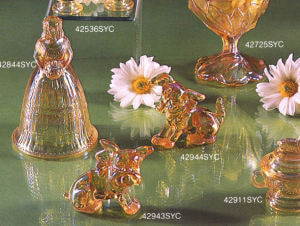Imperial Revival Carnival Glass
In the early 1960s, Imperial - as well as Fenton and other glassmakers - saw the developing market for the revival of Carnival Glass production. Re-issues were aimed directly at the collector market, recognising the popularity of Classic (old) Carnival, and they used the name "Carnival Glass" as it was the generally accepted name for this type of collectable glass. In fact, their ads in 1962 read: "Genuine and authentic 'Carnival Glass' American Handmade by Imperial USA. From moulds used 60 years ago."
In another throwback to names used for their Classic Carnival colours, Imperial revived the terms "Rubigold" and "Peacock" to describe their early re-issued colours; Rubigold was marigold (just as it was for their Classic Carnival), and Peacock was used to denote Revival Carnival in smoke. Over time, and seeing the popularity of Revival Carnival, Imperial introduced various new colours, as you can see in their catalogues (linked below).
|
When Imperial re-issued Carnival Glass, it made economic sense to revive some old Classic Carnival and EAPG patterns and moulds, as well as using entirely new moulds*. In response to collectors of Classic Carnival, Imperial decided to mark their Revival Carnival production with a moulded Imperial mark - initially "IG", then "LIG" and finally "ALIG" - see right. By the early 1970s, Imperial was badly in need of new capital, and the business became Lenox Imperial Glass in 1973. The IG mark changed to LIG, new colours and Limited Editions were introduced. In 1981 the Lennox Imperial glass business was sold to Arthur Lorch, and the LIG mark became ALIG. The business did not survive, and in August 1984, Imperial closed in bankruptcy. |
The three Imperial marks found on their Revival Carnival Glass.
|
There was a short-lived attempt to keep it going by a group of business people who formed a group called “Save Imperial Committee” to preserve the plant as a glassmaking enterprise and a tourist attraction. In around 1986-87, four ex-Fostoria glassmakers started making glass in a section of the old Imperial plant as part of the plan for a tourist attraction, operating as Pioneer Glass Company. The plan was ultimately unsuccessful, and the plant closed permanently.
* Bear in mind that when Imperial closed in 1984, their moulds were sold; other glassmakers, notably Fenton and L. E. Smith acquired a large number of them, and many were subsequently used again by these two companies.
This "Imperial Revival Homepage" provided links to all the information on our website - catalogues, pattern identification, dates of production, adverts, images of original moulds and insights into Imperial's amazing Revival Carnival output.
Simply click on a "thumbprint" to explore this wonderful resource about Imperial's Revival Carnival.
There was a short-lived attempt to keep it going by a group of business people who formed a group called “Save Imperial Committee” to preserve the plant as a glassmaking enterprise and a tourist attraction. In around 1986-87, four ex-Fostoria glassmakers started making glass in a section of the old Imperial plant as part of the plan for a tourist attraction, operating as Pioneer Glass Company. The plan was ultimately unsuccessful, and the plant closed permanently.
* Bear in mind that when Imperial closed in 1984, their moulds were sold; other glassmakers, notably Fenton and L. E. Smith acquired a large number of them, and many were subsequently used again by these two companies.
This "Imperial Revival Homepage" provided links to all the information on our website - catalogues, pattern identification, dates of production, adverts, images of original moulds and insights into Imperial's amazing Revival Carnival output.
Simply click on a "thumbprint" to explore this wonderful resource about Imperial's Revival Carnival.











